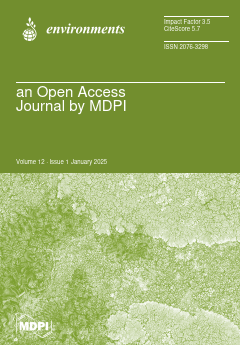Water and its management have played a pivotal role in the evolution of organisms and civilizations, fulfilling essential roles in personal use, industry, irrigation, and drinking from ancient times to the present. This study seeks to evaluate groundwater quality for irrigation and drinking
[...] Read more.
Water and its management have played a pivotal role in the evolution of organisms and civilizations, fulfilling essential roles in personal use, industry, irrigation, and drinking from ancient times to the present. This study seeks to evaluate groundwater quality for irrigation and drinking in the Northern Peloponnese region, specifically the wells of Loutraki and Schinos areas and the springs of the Gerania Mountains (Mts.), using geo-environmental indices and ionic ratios. For the first time, geo-environmental indices have been applied to a region where groundwater serves multiple purposes, addressing the challenge of understanding their dynamics to optimize their application in environmental science and groundwater pollution research. To achieve this, 68 groundwater samples from the study area were utilized, and a total of 25 geo-environmental indices were calculated to assess water quality. These indices examined: (i) drinking suitability (NPI, RI, PIG, WQI, and WPI), (ii) irrigation suitability (SAR, KR, %Na, PS, MAR, RSC, SSP, TH, PI, IWQI, and TDS), (iii) potentially toxic element (PTE) loadings (Cd, HEI, and HPI), and (iv) major hydrogeochemical processes, expressed as ionic ratios (Ca/Mg, Ca/SO
4, Ca/Na, Cl/NO
3, Cl/HCO
3, and Si/NO
3). Data processing involved descriptive statistics, hydrogeochemical bivariate plots, Spearman correlation coefficients, and multivariate statistical analyses, including factor analysis (FA) and R-mode hierarchical cluster analysis (HCA). Results revealed that all groundwater samples (100%) from the Loutraki area and the Gerania Mts. were of good quality for both drinking and irrigation purposes. In contrast, groundwater from the Schinos area exhibited lower quality, with most samples (93.9%) considered suitable only for irrigation. The deterioration in the coastal aquifer of the Schinos area is attributed to elevated concentrations of Cl
−, Na
+, NO
3−, As, and Cr resulting from salinization and relatively limited anthropogenic influences. The study highlights that relying on individual geo-environmental indices can yield misleading results due to their dependence on factors such as researcher expertise, methodological choices, and the indices’ inherent limitations. Consequently, this research emphasizes the necessity of combining indices to enhance the reliability, accuracy, and robustness of groundwater quality assessments and hydrogeochemical evaluations. Last but not least, the findings demonstrate that calculating all available geo-environmental indices is unnecessary. Instead, selecting a subset of indices that either reflect the impact of specific elemental concentrations or can be effectively integrated with others is sufficient. This streamlined approach addresses challenges in optimizing geo-environmental index applications and contributes to improved groundwater resource management.
Full article





